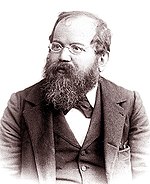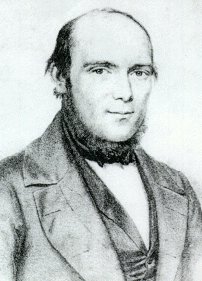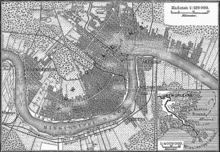World Chess Championship 1886
| Portraits | ||
|---|---|---|
| Wilhelm Steinitz | Johannes Hermann Zukertort | |
| nation |

|
|
| status | Winner against Adolf Anderssen in 1866 |
Winner of the London Tournament in 1883 |
| Age | 49 years | 43 years |
The 1886 World Chess Championship was the first official World Chess Championship .
It is true that duels between the best chess players had taken place several times in the history of chess. But the world title "Champion of the World" was awarded for the first time in the duel between the Austrian Wilhelm Steinitz, who lives in the United States, and the originally Polish player Johannes Hermann Zukertort , who is now based in the United Kingdom .
Steinitz had considered himself world champion since his duel victory against Adolf Anderssen in 1866. Zukertort had won the heavily occupied London tournament in 1883 before Steinitz and now claimed the title in turn. In order to resolve this disagreement and establish a single, generally recognized world chess champion, the two opponents should fight a title fight aimed at ten wins from any number of chess games. This title fight was the first chess world championship recognized by all chess historians and took place from January 11th to March 29th, 1886 in the United States . After 20 games played in New York City , St. Louis and New Orleans , Wilhelm Steinitz had achieved the necessary ten victories in five draws and five defeats and was the first generally recognized world chess champion with the title “Champion of the World”.
prehistory
In Europe, North America and Australia, chess masters had competed in tournaments since the middle of the 19th century. Strong chess masters had also fought duels against each other on several occasions, beginning with the duel between Alexander McDonnell and Louis-Charles Mahé de La Bourdonnais in 1834 .
Steinitz was already considered the strongest Prague player in childhood. After success at tournaments of the Vienna Chess Society, Steinitz caused a sensation at a London tournament. Although he only finished last, his bold style was praised by tournament winner Adolf Anderssen.
Competition 1866 1 2 3 4th 5 6th 7th 8th 9 10 11 12 13 14th Victories Points Adolf Anderssen 1 0 0 0 0 1 1 1 1 0 0 1 0 0 6th 6th Wilhelm Steinitz 0 1 1 1 1 0 0 0 0 1 1 0 1 1 8th 8th
From July 14th to August 10th 1866 there was a duel in London between Adolf Anderssen, who is considered the strongest chess player in the world, and Wilhelm Steinitz, which Steinitz won with 8: 6 points. In this duel, as in any games between the two opponents, there was no draw.
Competition 1872 1 2 3 4th 5 6th 7th 8th 9 10 11 12 Victories Points Wilhelm Steinitz 1 1 ½ ½ 1 1 ½ 0 1 1 ½ 1 7th 9 Johannes H. Zukertort 0 0 ½ ½ 0 0 ½ 1 0 0 ½ 0 1 3
Zukertort learned to play chess at the University of Breslau while studying medicine. His great chess career began while he was living in England, around 1872, after having previously trained with Anderssen. From August 6 to September 5, 1872, Steinitz and Zukertort fought a first duel against each other in London, which Steinitz won with 9: 3 points.
Steinitz did not play any serious tournaments after his victory in the Vienna tournament in 1873, while Zukertort stood out with positive results during these years. The peak of Zukertort's skill level was reached after several victories in English tournaments in the following years and the tournament victory in Paris in 1878.
At the beginning of 1882, Steinitz proposed a consultation competition against Zukertort, which, however, he refused. Instead, Zukertort was ready to "play alone with Steinitz under acceptable conditions". If Steinitz did not want this, he should play at the Vienna tournament in 1882. Steinitz took part in the Vienna chess tournament in 1882 and achieved victory together with Winawer , while Zukertort ended up in shared fifth place. Steinitz often poked at Zukertort for this, even after the tournament in London in 1883, which was considered the strongest tournament in the world . Johannes Hermann Zukertort won this tournament ahead of Wilhelm Steinitz and then questioned Steinitz's status as Champion of the World , as he now considered himself the title holder.
Wilhelm Steinitz moved to the United States in August 1883, but did not receive citizenship until November 23, 1888. He only changed his first name to William around the time he was granted citizenship.
Zukertort was tired of Steinitz's taunts about avoiding a duel, and so in March 1885 he had a challenge printed on it in Chess Monthly magazine . Both parties should appoint a second and the latter an arbitrator.
In January 1885 the German chess newspaper Zukertort certified that it was still at the zenith of its fame and its artistry. The Steinitz playing style was described by Richard Mangelsdorf elsewhere shortly before the World Cup as safe. Wilhelm Steinitz himself reported in the International Chess Journal shortly before the start of the competition that his health had improved significantly since he had lived in the United States.
organization
On March 28, 1885, Steinitz appointed Manhattan Chess Club secretary Gustav Simonson as a provisional second. On May 30, 1885, Zukertort appointed the secretary of St. George's Chess Club in London, James Innes Minchin. The seconds were later replaced by Thomas Frére for Steinitz and Charles Möhle for Zukertort. Frére and Minchin negotiated how the competition would come about. On December 29, 1885, the game contract was signed by Steinitz and Zukertort.
The event, largely financially supported by patrons , was planned for around nine months. Among other things, the reflection time , victory conditions and financial regulations were discussed.
Playing conditions
Since double clocks were first used at the London tournament in 1883, there was little experience with them. Zukertort asked for two hours to think about 40 moves, while Steinitz insisted on a longer reflection time. The contracting parties finally agreed on two hours for 30 trains and one hour each for 15 additional trains. Games should be played every other day from 2:00 p.m. to 6:00 p.m. and continued from 8:00 p.m. to 12:00 p.m. Aborted games should be completed on the rest days. In the case of a medically determined illness, up to three days of rest could be claimed. There was no time limit for delays to games, but the time was counted towards the reflection time. In the event of a game being abandoned, the drafts had to be written down in words and were noted in the usual notation on the game forms when the game was restarted.
For the repetition of positions , the special rule was agreed that, in deviation from the valid chess rules of the German Manual, if a series of moves is repeated six times, both players have the right to claim a draw.
Acts that unfairly harm or offend the opponent during the game were fined from ten to one hundred US dollars . Violations of the rules were fined between five and fifty US dollars and fined fifty to two hundred and fifty US dollars for delays in the duel or behavior that would be detrimental to revenue from the duel. All fines would benefit the enemy.
Venues
Up to the first four victories of a party was played in New York City, then up to three more victories of a party should be guested in St. Louis, in order to continue the fight until the decision in New Orleans. The first venue was Cartier's Rooms at 80 Fifth Avenue in New York City; a venue that had chess historical significance insofar as Paul Morphy fought and won a duel against Louis Paulsen at the first United States chess congress in 1857 . Steinitz and Zukertort used the same board and pieces as Morphy and Paulsen. Forty spectators attended the opening of the World Chess Championship and a demonstration board was used for the first time . The live transmission to various chess clubs in the United States and London was ensured by telegraph . For this purpose, telegrams ( cable dispatches) with the results were sent.
Framework
The winner of the World Chess Championship should be the player who wins ten wins first. Draw games were not counted. With a score of 9: 9 wins, the match should be counted as a draw and the world championship title should not be awarded. Both counterparties deposited a stake of 2000 US dollars each. The winner of the duel should receive the full amount. Most recently, Steinitz, the winner of the duel, received $ 4,000 in prize money, but Zukertort also received $ 750. Furthermore, Steinitz is said to have received around $ 1000 by betting on his victory, but this could not be proven.
The arbitrator and stakeholder was Charles F. Buck from New Orleans.
Point 7 of the sub-rules and agreements of the competition provided for the use of a demonstration board for the spectators and allowed the use of pocket chess games. However, analysis was prohibited . The exploitation rights of the chess games should belong to Steinitz and Zukertort.
course
The following table gives an overview of the results and time consumption of the counterparties. In most of the games, the rejected Queen's Gambit and the Spanish game were up for debate.
| Lot | Place * | Date (1886) | Game result | opening | ECO code | Trains | time | Victories | ||||
|---|---|---|---|---|---|---|---|---|---|---|---|---|
| Steinitz | Zuckerort | Steinitz | Zuckerort | Lot | Steinitz | Zuckerort | ||||||
| 1 | NYC | 11th January | 1 | 0 | Queen's Gambit declined | D11 | 46 | 2: 45h | 2: 30h | 5: 15h | 1 | 0 |
| 2 | NYC | 13th January | 0 | 1 | Scottish game | C47 | 46 | 3: 20h | 2: 36h | 5: 56h | 1 | 1 |
| 3 | NYC | 15. January | 0 | 1 | Queen's Gambit declined | D10 | 47 | 3: 05h | 2: 15h | 5: 20h | 1 | 2 |
| 4th | NYC | January 18th | 0 | 1 | Spanish game | C67 | 39 | 2: 30h | 1: 25h | 3: 55h | 1 | 3 |
| 5 | NYC | January 20th | 0 | 1 | Queen's Gambit declined | D10 | 32 | 2: 15h | 1: 15h | 3: 30h | 1 | 4th |
| 6th | SL | 3 February | 1 | 0 | Spanish game | C67 | 61 | 3: 33h | 1: 53h | 5: 26h | 2 | 4th |
| 7th | SL | February 5th | 1 | 0 | Queen's Gambit declined | D40 | 35 | 2: 10h | 2: 05h | 4: 15h | 3 | 4th |
| 8th | SL | February 8 | ½ | ½ | Spanish game | C67 | 22nd | 1: 15h | 0: 20h | 1: 35h | 3 | 4th |
| 9 | SL | February 10th | 1 | 0 | Queen's Gambit declined | D26 | 38 | 2: 12h | 1: 55h | 4: 07h | 4th | 4th |
| 10 | NO | February 26th | ½ | ½ | Spanish game | C67 | 21st | 0: 58h | 0: 23h | 1: 21h | 4th | 4th |
| 11 | NO | 1st March | 1 | 0 | Spanish game | C49 | 42 | 2: 39h | 1: 25h | 4: 04h | 5 | 4th |
| 12 | NO | 3 March | 1 | 0 | Spanish game | C67 | 44 | 2: 37h | 1: 35h | 4: 12h | 6th | 4th |
| 13 | NO | 5. March | 0 | 1 | Queen's Gambit declined | D26 | 86 | 4: 55h | 3: 10h | 8: 05h | 6th | 5 |
| 14th | NO | March 13th | ½ | ½ | Spanish game | C67 | 48 | 2: 55h | 1: 20h | 4: 15h | 6th | 5 |
| 15th | NO | March, 15 | ½ | ½ | Queen's Gambit declined | D35 | 49 | 2: 14h | 1: 02h | 3: 16h | 6th | 5 |
| 16 | NO | 17. March | 1 | 0 | Spanish game | C65 | 49 | 2: 45h | 2: 10h | 4: 55h | 7th | 5 |
| 17th | NO | 19th March | ½ | ½ | Queen's Gambit declined | D53 | 52 | 2: 35h | 1: 35h | 4: 10h | 7th | 5 |
| 18th | NO | March 22 | 1 | 0 | Spanish game | C65 | 40 | 2: 10h | 1: 15h | 3: 25h | 8th | 5 |
| 19th | NO | March 24th | 1 | 0 | Queen's Gambit declined | D53 | 29 | 1: 04h | 1: 00h | 2: 04h | 9 | 5 |
| 20th | NO | March 29 | 1 | 0 | Steinitz Gambit | C25 | 19th | 0: 30h | 0: 30h | 1: 00h | 10 | 5 |
According to Minckwitz, the total time taken during the competition was 48:27 hours for Steinitz and 31:39 hours for Zukertort, for a total of 80:06 hours. 844 moves were played.
New York City
The New York City host was the Manhattan Chess Club , founded in 1877 , which raised $ 1,000 for this purpose. From December 5 to 13, 1885, Zukertort drove the RMS Etruria from Liverpool to New York City. In addition to Steinitz, a chess delegation from the United States received him there. After several weeks of preparation, the first duel for the world chess championship began on January 11, 1886. This was rated by Minckwitz in his book published in 1886 as "the most important chess competition of all time".
Of the first five games, Zukertort won four and Steinitz one. An eight-day break followed until the opponents drove to St. Louis to continue the duel.
St. Louis
In St. Louis, the duel continued at the St. Louis Chess, Checkers and Whist Club .
With the Spanish opening, Steinitz won the first game in St. Louis. At the beginning of February 1886, the Illustrirte Zeitung predicted during the 4: 2 leadership of Zukertort that he would probably not keep his lead due to a lack of perseverance. In the February 13 issue, the newspaper noted that the prediction had been confirmed and that Steinitz would probably win the duel. After Steinitz added three more to his win from New York City, the duel was moved to New Orleans when the score was 4-4.
New Orleans
In New Orleans, Steinitz and Zukertort played in the New Orleans Chess, Checkers and Whist Club .
Zukertort only won one of the last eleven games, whereby Steinitz won the title "Champion of the World" with a score of 10: 5 wins.
aftermath
World title
Wilhelm Steinitz later became a citizen of the United States and changed his first name to William. As this he defended his world championship in 1889 , 1890 and 1892 until he lost it to Emanuel Lasker at the 1894 World Chess Championship .
Zukertort's death
Often, Zukertort's exhaustion during the 1886 World Chess Championship is made responsible not only for his defeat, but also for his death on June 20, 1888.
Game contract
The game contract between Steinitz and Zukertort has been privately owned by a collector since the Manhattan Chess Club was dissolved in 2002.
Individual evidence
- ↑ Minckwitz, pp. 1-2
- ↑ a b chessgames.com: Zukertort vs Steinitz 1886 , accessed on April 20, 2009
- ↑ Source: BigDatabase 2005
- ↑ See http://www.mark-weeks.com/chess/w$s$$mix.htm for more duels from Steinitz in London.
- ↑ a b c Minckwitz, p. 5
- ^ A b Kurt Landsberger: William Steinitz, Chess Champion: A Biography of the Bohemian Caesar. McFarland, Jefferson 1993, ISBN 0-89950-758-1 , pp. 206 f.
- ↑ a b http://www.koenig-plauen.de/Rubriken/Weltmeister/steinitz.htm
- ↑ Minckwitz, pp. 6-7
- ^ Biographical sketches . In: Minckwitz, pp. 13-18
- ↑ Minckwitz, pp. 8-9
- ↑ Minckwitz, pp. 7-8
- ↑ a b c d e f g Steinitz & Zukertort: Contracts between the players . In: Minckwitz, pp. 19-27.
- ↑ a b c New York Times , January 12, 1886. Preview or full text as PDF file (PDF file requires cookies from nytimes.com)
- ↑ Note: Location on Google Maps
- ↑ a b chessbase.de: Steinitz versus Zukertort , March 29, 2006
- ↑ Minckwitz, p. 12. Postscript by D. O.
- ↑ http://www.mark-weeks.com/chess/y6sz$wix.htm
- ↑ Minckwitz, pp. 198-199
- ^ Modified taken from Minckwitz, p. 202
- ^ Col. FW Morse: The Manhattan Chess Club - the first 21 years . Chess Magazine, February 1898. Online reprint from Sarah's Chess Journal
- ↑ Minckwitz, p. 8
- ↑ Minckwitz, p. 9
- ↑ Minckwitz, p. 10
- ↑ Minckwitz, pp. 10-11
literature
- J. Minckwitz (Ed.): The decisive battle between W. Steinitz and JH Zukertort for the championship of the world . Schach-Verlag Adolf Roegner, Leipzig, April 27, 1886 ( public domain , but only accessible with a proxy ).
- Raymund Stolze : Contested crown. Sportverlag, Berlin 1992, ISBN 3-328-00526-9 .
Web links
- Information at mark-weeks.com (English)
- Report at chessgames.com (English)





